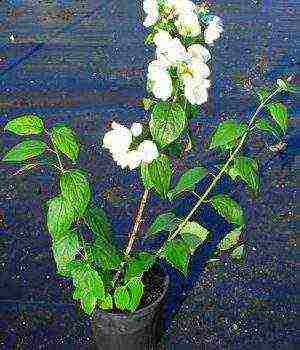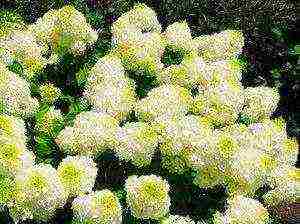Content
The ancient Greeks called the chrysanthemum "the golden flower". And they had reasons for that. These flowers, like the sun, open their heads in the autumn months, filling the garden with their specific aroma. According to ancient Eastern wisdom, those who grow them are happy and live long.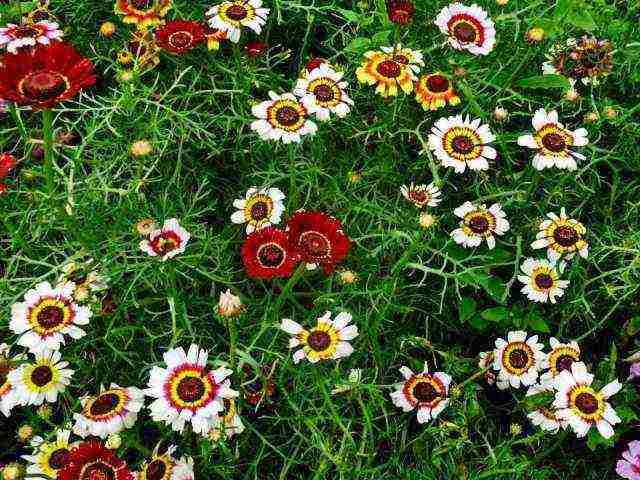
general information
From the second half of July, and in some regions closer to September, many different varieties of this flower can be seen in their personal plots and in flower beds in gardens. Most flower growers prefer to choose annual chrysanthemums, the cultivation of which is not difficult, besides, they have excellent decorative properties and relative unpretentiousness. Of course, outwardly, they are slightly inferior to perennial varieties, but they do not require complex and time-consuming care.
The annual chrysanthemum is a member of the Asteraceae family. Its genus includes more than forty species of these herbaceous plants. It is believed that the annual chrysanthemum came to us from the Mediterranean. There is hardly a person who will remain indifferent to the beauty of this flower. More often than others in our gardens there is an annual Kilevataya chrysanthemum. Although in some regions other varieties are quite common, for example, Posevnaya, Uvenchannaya and other varieties. Their bright, cheerful inflorescences, gathering in simple and semi-double baskets, adorn flower beds from mid-June to mid-October.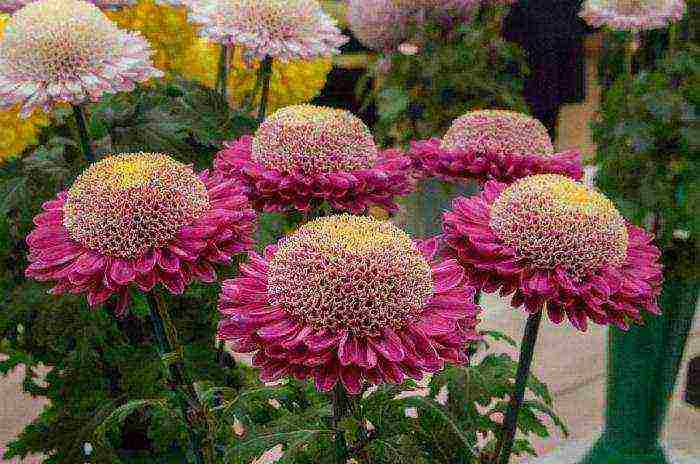
Description
Almost every person who was born in the era of the USSR, this plant evokes childhood memories. After all, the first thing that we saw at the dacha or in the village with grandparents was the one-year-old chrysanthemum. Photos of this flower are presented in this article. This culture is relatively undemanding to growing conditions. Chrysanthemum rhizomes are branched, they develop parallel to the surface. Shoots are either naked or pubescent.
The annual chrysanthemum has alternate leaves. They are simple, but vary in shape and size. The plant may have notched or serrated, dissected leaves, or may not even be present at all. The color of the green is usually light, although in some varieties it can be dark. Small chrysanthemum flowers are collected in a basket. Sometimes it can be quite large. The fruits of the chrysanthemum are achenes.
This plant begins to bloom somewhere in mid-June for two months. This period may vary depending on the region. Due to its abundant and very long flowering, the annual chrysanthemum is used with great success in landscape design. It is beautiful on ridges and prefabricated flower beds, it is often planted in large groups against the backdrop of a lawn. The annual chrysanthemum is also suitable for cutting, as it can stand in the water for a long time.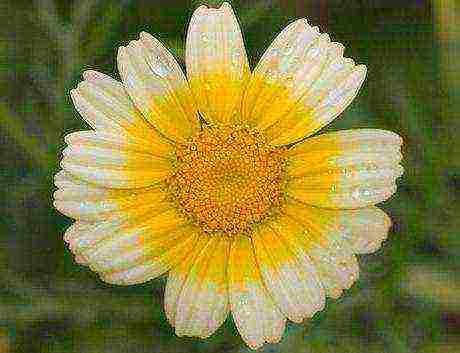
Varieties
In our country, several decorative types are most common. One-year-old chrysanthemum Vidnaya is most often found in gardens. Its bushes are about fifty centimeters high. The foliage is graceful and arranged, the inflorescences are large (5-6 cm), terry, with a pronounced convex receptacle. The plant blooms for a very long time. Particularly good is the chrysanthemum seen in the cut, therefore it is also called "bouquet".
Another variety - Sowing - has highly branched bushes, covered with large lemon flowers with a contrasting dark brown core.Chrysanthemum seeds Scaphoid gave the name to this species. They look like a boat with a keel, because the variety is also called Kilevataya. The inflorescences of this chrysanthemum are very colorful, its flat dark red-brown disc is surrounded by reed petals with multi-colored rings: white, red, pink, burgundy, yellow, brown, orange. There are so many variations that it is impossible to find two bushes with the same coloring.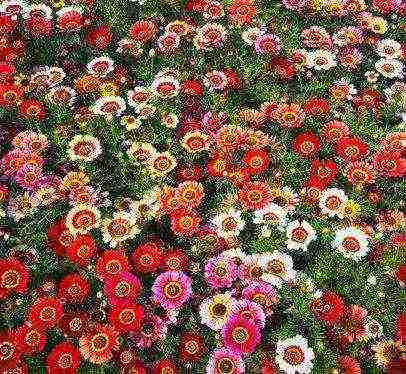
Care
The plant prefers fertile and well-drained soil. It easily sets seeds, and some varieties are characterized by abundant self-seeding. Young annual chrysanthemum grows quickly enough. This flower is undemanding to care, cold-resistant and tolerates light frosts. He loves a sunny location in the garden.
The annual chrysanthemum is a fairly drought-resistant plant that does not tolerate excess moisture. In order for the plant to bloom on time and enjoy until late autumn, it must be planted in sunny open areas. If the place is shaded, then the annual chrysanthemum will stretch out, and the color of the buds will be very dull, and the flowering will be short-lived. Does not like the plant and cold winds.
Soil preparation
Chrysanthemums prefer medium-heavy, loamy and water-intensive soil with good drainage, rich in micronutrients. It is strongly not recommended to grow them in acidic soil, since the flower feels very bad on it. The normal growth of chrysanthemums is also negatively affected by unripe manure.
Before planting, two buckets of humus, superphosphate and potassium magnesium should be added to the soil at the rate of fifty grams per square meter. Then the place needs to be dug to a depth of about two bayonets of the shovel, after that, plant the culture and water it abundantly.
Landing
The plant is able to grow on almost any garden soil, although it prefers a fertile, limed soil without an excess of organic compounds. Annual chrysanthemum grows best on loam. The plant is sown for seedlings in April, diving into pots. Planting material is transferred to the ground in mid-May. Seedlings are sown at a distance of twenty to thirty centimeters from each other.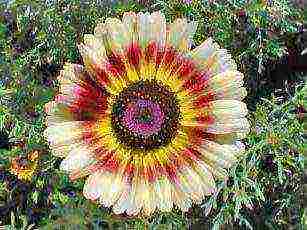
The planting material is sown only after the soil has been warmed up by the sun, in pre-prepared furrows. Then they are covered with peat two to three centimeters thick and watered well. After the formation of the first pair of true leaves, the seedlings should be thinned out.
Growing features
For the lush growth of an annual chrysanthemum, timely and high-quality watering is necessary. The flower also needs periodic loosening of the soil with the elimination of all weeds. After planting, it is better to mulch the soil around it: this helps to maintain the necessary moisture at the roots.
Like any other flower crop, the annual chrysanthemum requires periodic feeding. In this case, the main thing when applying fertilizers is to water it at the root so as not to burn the leafy part.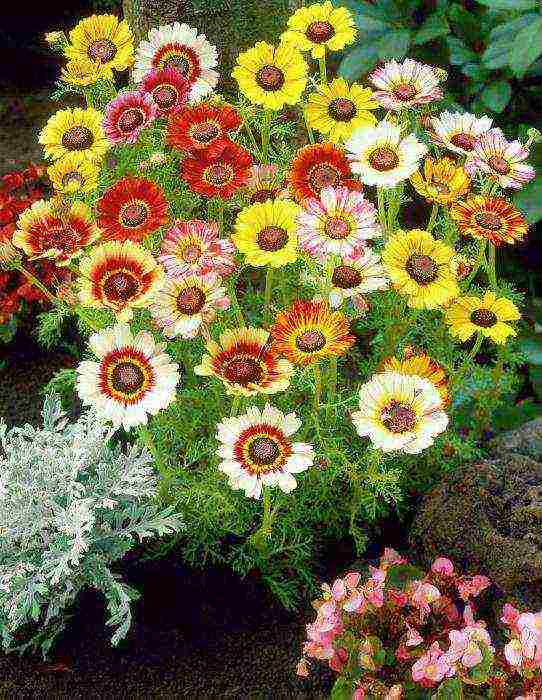
Chrysanthemum annual: growing from seeds
In the middle zone of our country, this culture is grown both by sowing in the ground and by seedlings. The seeds of all varieties of annual chrysanthemums are sown in March or April in a greenhouse in compost soil with the addition of peat and sand. The seed is sprinkled with leafy soil, pressed lightly, and then watered quite abundantly. With dense cultivation of seeds, it is imperative to thin out the seedlings.
Other prerequisites for normal growth are regular watering and airing the greenhouse. The latter procedure is extremely important, since the annual chrysanthemum grows very quickly, so at high temperatures it can outgrow, and in this case the seedlings will turn out to be incomplete. The end result should be a squat plant with well-developed roots.
Seedlings of annual varieties are best placed in open ground only in May.Blooming chrysanthemum is a real decoration of gardens in autumn. This bright gift of nature, with a wormwood tart aroma, seems to be sent to prolong summer days.
 Garden chrysanthemum (Latin Chrysanthemum × hortorum) is also known as mulberry chrysanthemum and Chinese chrysanthemum. This autumn flowering culture is popular in landscape gardening. Chrysanthemum is a group of complex hybrid forms and varieties of the genus Chrysanthemum. The plant is characterized by long, abundant and very beautiful flowering. By properly caring for the chrysanthemum, you can create a magnificent flower arrangement yourself.
Garden chrysanthemum (Latin Chrysanthemum × hortorum) is also known as mulberry chrysanthemum and Chinese chrysanthemum. This autumn flowering culture is popular in landscape gardening. Chrysanthemum is a group of complex hybrid forms and varieties of the genus Chrysanthemum. The plant is characterized by long, abundant and very beautiful flowering. By properly caring for the chrysanthemum, you can create a magnificent flower arrangement yourself.
General characteristics of chrysanthemums
The garden chrysanthemum is a perennial or annual plant., which has a thickened and to varying degrees of branched rhizome with stolonic underground shoots. Stems are erect, 25 cm to 1.2 m high, sometimes highly branched, with thin branches, abundantly leafy.

Leaves can have different shapes and degrees of dissection, in small-flowered plants they reach 7 cm in length and 4 cm in width, in large-flowered plants - 15 cm in length and 8 cm in width. The inflorescence is represented by a basket, consisting of a large number of reed or tubular flowers... The marginal part of the inflorescence is formed by ligulate unisexual female flowers, the central part is tubular bisexual. The shape, size and color of the inflorescences varies. Large-flowered plants can form few seeds, most of which are knotted in tubular flowers.

Chrysanthemum species
Depending on the main characteristics and features of the structure, as well as the application, varieties and hybrid forms of garden chrysanthemums are divided into several groups.
| Group name | Features and characteristics |
| Large-flowered | Indian or greenhouse chrysanthemums, intended for cutting. They form the largest flower possible and need timely pinching to obtain a full-fledged primary bud |
| Twiggy, branched, spray | Cutting group. Form on one branch a whole bouquet of bright and very beautiful inflorescences |
| Potted | A widespread group characterized by a variety of colors and abundant flowering. Forms beautiful spherical inflorescences on low bushes. Most often used for forcing |
| Korean bush | A group of winter-hardy flowering chrysanthemums, absolutely undemanding to care for. Plants grow quickly and form very massive bushes |
Depending on the shape of the inflorescence all garden bush chrysanthemums of European, Chinese and Japanese selection are divided into several groups (classes).
| Class name | Peculiarities |
| Pompom | They have small, fully double, almost regular, rounded inflorescences |
| Cirrus | They have double inflorescences, the petals of which completely cover the central part of the flower |
| Bristly | They resemble feathery chrysanthemums, but have thinner petals (sometimes curved) |
| Simple and semi-double | They have almost flat inflorescences and an open central part of the flower, framed by one or more rows of petals |
| Anemone | They have inflorescences similar to the inflorescences of semi-double chrysanthemums, but differing from them in a slightly raised and lush central part |
| Japanese fantasy | Cirrus varieties and hybrid forms obtained relatively recently. Characterized by elongated petals |
| Spoon-shaped | They have some similarity with simple and semi-double chrysanthemums, differing from them by the presence of a spoon-shaped expansion at the ends of the petals |
The group of cold-resistant garden chrysanthemums is represented by hybrids and varieties of Korean selection, which are in demand for cultivation in central Russia. Some of them are capable of wintering in open ground conditions.
Popular varieties
Chrysanthemums are so popular with professional flower growers and amateurs that breeding work on the development of new varieties and hybrids is ongoing. This allows you to get more interesting and stable shapes.
How to plant a chrysanthemum (video)
Annual chrysanthemums
In domestic floriculture, three varieties of annual garden chrysanthemums are most popular: tricolor, field and crown.
| Name | Description |
| Tricolor | Plant height - 60 cm. Stem with branches covered with thick feathery leaves of gray-green color. Inflorescences are predominantly solitary, with a diameter of 4 to 6 cm. The outermost flowers are monochromatic or multicolored, with various coloration at the base. There are varieties with copper-red inflorescences with yellow edging and a dark central part, as well as varieties with yellow inflorescences with a dark central part and white inflorescences with a light yellow center. |
| Sowing, or field | Plant height varies from 30 to 60 cm. The stem is branched, with feathery leaves on the lower part and serrated leaves on the upper part. The flowers are similar to large field daisies with a flat, light or dark center and white, gray-yellow or yellow petals. The diameter of the inflorescence is from 3 to 5 cm. |
| Crown, or crowned | It is characterized by very strong growth. The height of the stem can reach 1 m. The shoots are highly leafy. The leaves are pinnate, with lanceolate, toothed areas. Inflorescences with a diameter of 3 cm, located on long pedicels. Several inflorescences are formed on each shoot. The color of the reed flowers ranges from yellow to white. Tubular flowers, green-yellow |
Perennial chrysanthemums
Garden perennial chrysanthemums are one of the few flowering plantsthat perfectly tolerate a cold snap. They effectively complement plantings with spruce, juniper, tamarisk or flower perennials - solidago, asters and tagetes.
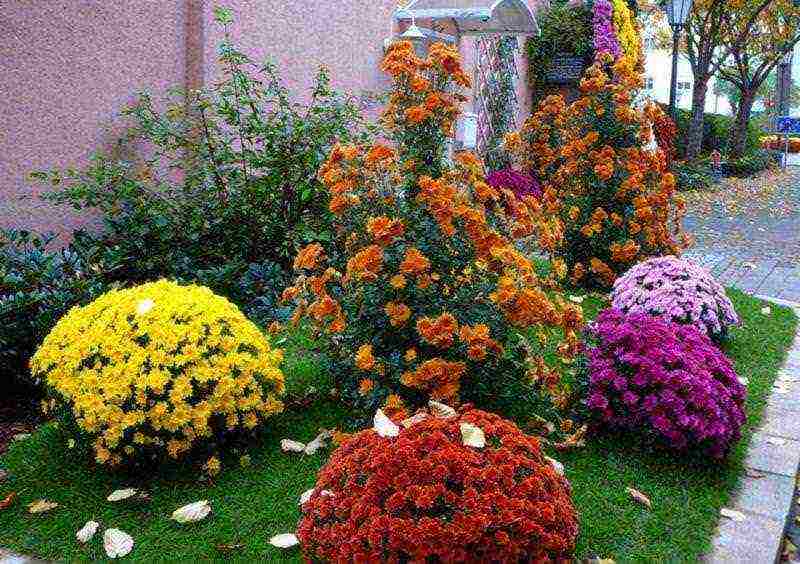
| Name | Description |
| Autumn sun | The flowers are bright yellow, with a pronounced honey aroma. Shrub 60–62 cm high. Flowering begins in August and lasts until frost |
| Autumn sunset | The flowers are red, simple. The height of the bush is 45–47 cm. Flowering lasts until frost |
| Koreanochka | The flowers are bronze with golden edging. The height of the bush is 65–67 cm. Flowering lasts until frost |
| Pink daisy | The flowers are brownish-pink, simple, non-double. Plant height - up to 60 cm.Flowering begins in August and lasts until September |
| Modesty | The flowers are white with a pinkish tinge. The standard height of the bush is 60-62 cm. Flowering lasts from August to September |
| Gold tips | The flowers are copper-red with golden edging, semi-double. The height of the bush is up to 65 cm.The flowering lasts until frost |
| Daisy | The flowers are white with a cream shade, semi-double. The height of the bush is 65–67 cm. Flowering lasts from August to the last decade of September |
| Curb yellow | The flowers are bright yellow, simple, non-double. The height of the bush is 50-52 cm. Flowering lasts from August to mid-October |
| Late red | The flowers are velvety red, simple, non-double. The average height of the bush is 65–67 cm. Flowering lasts from September until frost |
Among flower growers of our country, such varieties of chrysanthemums as Gazellé and Alec Bedser, as well as spherical Korean and rainbow chrysanthemums, represented by Zembla and Anastasia varieties, are especially popular.
Flower reproduction methods
Chrysanthemums are propagated, as a rule, in a vegetative way, since propagation by seeds does not allow preserving the varietal characteristics of the plant. In most cases, the following are used:
- division of bushes;
- cuttings;
- separation of root growth from mother bushes.
Dividing the bushes is one of the easiest and most affordable ways to reproduce chrysanthemums. The most high-quality and effective cuttings are considered, which is carried out based on the varietal characteristics of the plant.Reproduction by root suckers formed around the bush occurs by separating them from the mother plant and planting them in a new place.
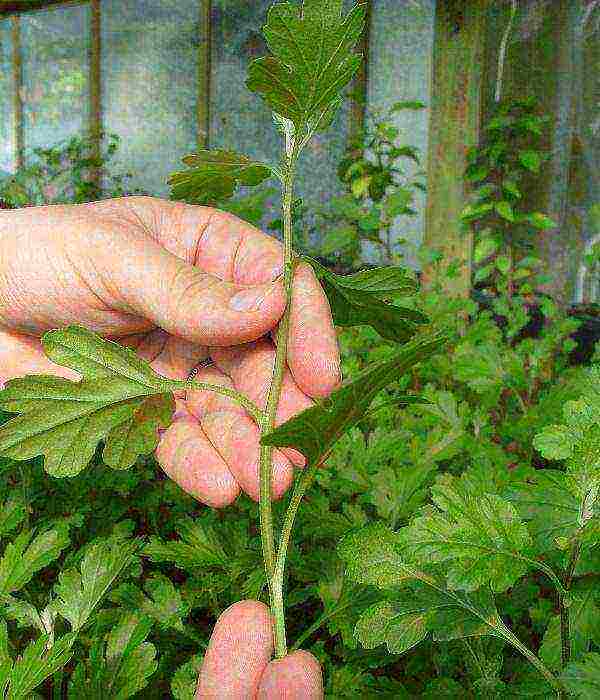
Correct fit technology
Planting garden chrysanthemums requires special conditions., on which the survival rate of the plant, as well as the duration and quality of flowering, directly depend.
Ground requirements
Chrysanthemums do not like even slight shading, as well as moisture retention in the soil, so the place for growing a plant should be as sunny and slightly elevated as possible. Flowers are suitable for neutral or slightly acidic soils with a pH of 5.5–7.
Plants place high demands on the nutrient content of the soil. Chrysanthemum blooms in response to the shortening of the day and the lengthening of the night, therefore, this crop should not be planted under street lamps or other lighting fixtures that decorate the landscape.
Autumn planting
The optimal time for autumn planting of plants in open ground is the last decade of September and the first half of October.
- plants should not be deeply buried;
- compost, vermicompost, peat or humus must be added to the planting pits;
- after planting, the bushes must be watered abundantly with warm water.
The distance between plants can vary from 35 to 60 cm - depending on the variety and size of the bushes.
How to cut chrysanthemum (video)
Growing chrysanthemums from seeds in the open field
Usually annual chrysanthemums are grown from seeds. It is quite simple to cultivate flowers in the open field by seed method, but at the same time the biological characteristics of the plant must be taken into account and the following requirements must be observed:
- sowing seeds in open ground is carried out in mid-May;
- sowing is carried out in depressions located 20 cm from each other and abundantly spilled with water;
- a couple of seeds are placed in each depression, which are then sprinkled with fertile soil;
- to warm up the soil and maintain moisture, the crops are covered with plastic wrap;
- after the emergence of seedlings, the film is removed, and the seedlings are thinned out;
- 10 days after the emergence of shoots, weeding and feeding with liquid fertilizers (for example, "Ideal" or "Rainbow") is carried out;
- strongly elongated or weakened seedlings are sprayed with a solution of "Zircon" or "Epin-Extra".
To obtain early flowering of annual chrysanthemums, it is recommended to use seedlings growing from seeds. This method is also suitable for perennial varieties. To get high-quality seedlings, sowing seeds should be done in late February or early March.
Planting seedlings
For successful breeding of garden chrysanthemums, the following rules must be observed:
- seedlings should be obtained from apical cuttings that emerge from the ground from the root system;
- it is not recommended to use cuttings from shoots formed by old stems;
- The cuttings should be rooted at 14–16 ° C and then grown in a cool and well-ventilated area.
When purchasing chrysanthemum seedlings, you need to pay attention to their state of health and the number of buds represented by unopened flower baskets. The presence of green buds has a negative effect on further flowering.
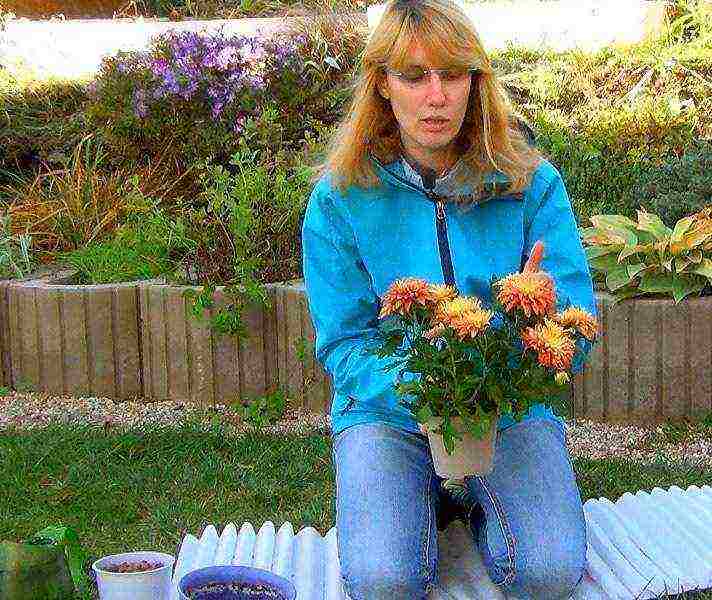
How to care for a chrysanthemum
Caring for a garden chrysanthemum does not differ significantly from caring for other flower plants grown in the open field. For normal development, chrysanthemums need regular weeding, watering and feeding.
Watering features
When planning watering for garden chrysanthemums, it is necessary to take into account the weather and climatic conditions, as well as the structure of the soil and the degree of illumination of the site. Irrigation should be carried out as needed, so that the earthen ball is always moist.

Chrysanthemum feeding
For feeding garden varieties, you can purchase ready-made mineral fertilizers, which can be used as early as a week and a half after planting. It is also recommended to use humates and complex compounds with a predominance of potassium and magnesium. During the development of green mass, garden chrysanthemums need a large amount of nitrogen and organic matter.
Pruning for the winter
Many small-flowered varieties of garden chrysanthemums winter very well, provided that the bushes are cut to a height of 20 cm and then covered with soil mounds. Preparation of plants for winter is carried out before the onset of frost.
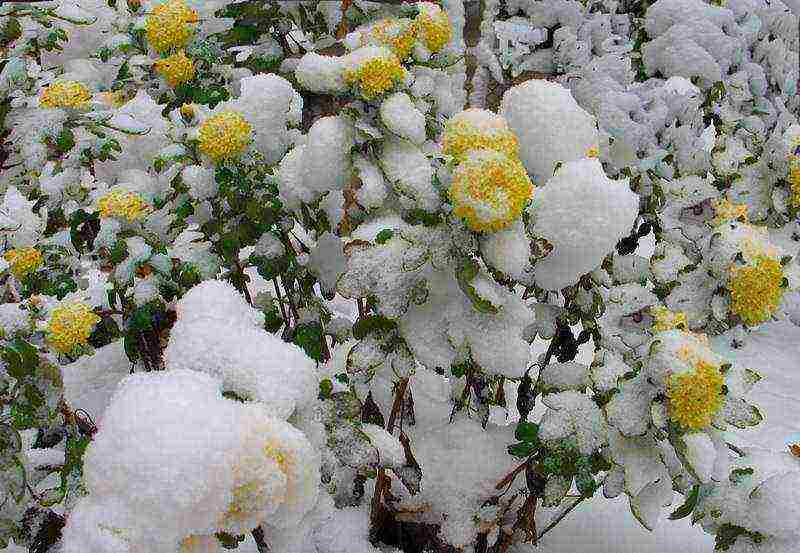
It is recommended to spud cut chrysanthemums, cover with an inverted box, and then spruce branches, which will retain the snow mass and retain heat. Heat-loving cut varieties must be dug out for the winter.
How to store chrysanthemum in winter (video)
Diseases and pests of chrysanthemums
The main enemies of the garden chrysanthemum are aphids, nematodes, meadow bugs, thrips, beetle larva and pennits. For pest control it is recommended to use the preparations "Confidor", "Fitoverm", "Fufanon", "Actellik", "Bi-2" and "Derris".
| Name of the disease | The first signs of defeat | Methods of prevention and treatment |
| Powdery mildew | The appearance of a white powdery bloom on leaves, stems and buds. Damaged plant parts dry out, development is inhibited | Removal of diseased plant parts. Treatment with Bordeaux liquid, "Cuprosil", "Blue-Bordeaux", "Champion", copper oxychloride, "Ridomil", "Quadris", "Strobi" or "Topaz" |
| Gray rot | On the aerial parts of the plant, rapidly growing light brown spots form. Decay of inflorescences occurs | Liming the soil. Monthly two-time treatment of plants with copper-containing products. Spraying with Bordeaux liquid before the flowering phase |
| Bacterial root cancer | Formation of characteristic growths on the root collar or stem | Destruction of affected bushes. Soil disinfection with formalin (150 g per 3 sq. M) |
| Leaf rust | The appearance on the leaf plates of yellow-green spots and convex waxy pustules of a pinkish hue | Removal and burning of diseased leaves. The introduction of phosphorus-potassium fertilizers. Treatment with a copper-containing agent "Fundazol" and 1% colloidal sulfur |
| Septoria, or leaf spot | The appearance on the leaf plate of brown-black spots merging with each other. The appearance of fungal spores on the leaves | Spraying with Bordeaux liquid or copper-soap solution, "Fundazol", copper oxychloride, "Kuprozan", "Tsineb", "Homecin" |
Garden chrysanthemum has long gained popularity among flower growers. Growing this flowering plant is a very exciting experience.
Attention, only TODAY!
Reviews and comments
The annual chrysanthemum is found in the form of a herbaceous culture and a dwarf shrub. People make legends about its origin. The "Golden Flower" adorns many household plots.
The root system of the flower is well developed, the roots spread along the line of the soil surface. The stems of the plant are of two types: naked and pubescent. The leaves on them are arranged in a regular sequence, the outline has jagged outlines. Just like shoots, leaves are pubescent and naked. Their color scheme can be of various shades of green.
Flowers are tubular flowers in the central part and ligulate flowers along the edge. Reed flowers can be arranged in one or more rows. The photo of an annual chrysanthemum shows a representative of a terry culture, where the petals are located one above the other.
The garden annual chrysanthemum is cultivated in several species. The most popular ones are:
- Crowned. The high representative of the flower. Stems reach 0.8 m and have strong branching. Inflorescences reach a diameter of 7 cm. The leaves are small, with a dissected contour.Tubular flowers are yellow, and reed flowers are white or yellowish;
- Sowing. The lower representative, the stems do not exceed 0.6 m. The leaves are oblong, with large denticles. The color range of inflorescences in white and yellow tones, size from 5 cm to 7 cm;
- Tricolor. Plant height ranges from 0.2 m to 0.7 m. Inflorescences are of the double type, the size is the same as in the previous species;
- Maiden. A small bush, heavily cut leaves, double flowers.
Some of the varieties presented are perennials, but gardeners are cultivating them as annual chrysanthemums.
The area for planting flowers is being prepared in the fall. Fertilizer is applied to it, the earth is loosened, a barrier from the wind is being prepared. Landing is done in a bright place. The most common method is sowing, which is done in two ways:
- planting in the ground;
- planting in a pot or box for germinating seedlings.
Chrysanthemum is grown from seeds easily in both cases. Their difference lies in the flowering time. Plants planted in the second way start flowering much earlier. And when growing a flower in soil, the first flowers can be seen only at the end of summer.
With a little effort, you can grow a vibrant arrangement of these common flowers. The flowerbed is diluted with other annuals. But there are so many varieties of chrysanthemum that you can only get by with them.
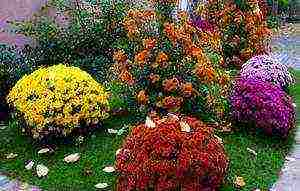 Chrysanthemums are very beautiful flowers of various shades that can decorate various rooms. At home, they grow very well, without causing much trouble in their maintenance and care. These plants are quite unpretentious and tolerate a drop in temperature well. They do not fade for a long time when cut, so they are often used in autumn bouquets. Many people think that chrysanthemums can only be grown by rooting a shoot or dividing a bush. However, this miracle can also be grown from seeds.
Chrysanthemums are very beautiful flowers of various shades that can decorate various rooms. At home, they grow very well, without causing much trouble in their maintenance and care. These plants are quite unpretentious and tolerate a drop in temperature well. They do not fade for a long time when cut, so they are often used in autumn bouquets. Many people think that chrysanthemums can only be grown by rooting a shoot or dividing a bush. However, this miracle can also be grown from seeds.
Description of the plant
Chrysanthemum is loved by many gardeners not only for its beautiful flowering, but also for the fact that it is one of the last to bloom and pleases the eye with its gorgeous appearance until the very cold weather. This flower in vivo found in China, North America, Asia and Europe... Chrysanthemum has many varieties, numbering about 150 pieces.
The cultivation of this flower takes place both at home and in the summer cottage. In the latter case, only two varieties are used:
- Korean;
- ground chrysanthemum.
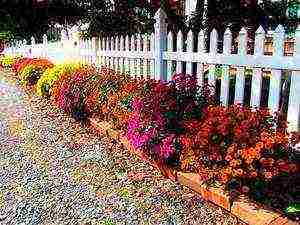
It belongs to the Asteraceae family of Compositae. It begins to bloom in September and ends in a month, in October. The height of the shrub is from 30 to 110 cm... The higher it is, the more flowers are formed on it, and under favorable conditions, up to 100 inflorescences with a double or semi-double surface can appear. The branched roots of the plant can penetrate the soil to a depth of 20 cm.
For growing on personal plots, the following types of chrysanthemums are most often acquired:
- Alpine;
- Crowned;
- Keeled;
- Shrub;
- Chinese;
- Korean.
Hybrid varieties tolerate temperature extremes and bad weather much easier. They are less likely to be affected by pests and various diseases, and they differ in a long flowering period.
How to grow a chrysanthemum from seeds?
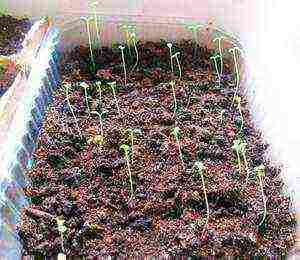 Growing a flower from seeds does not require special conditions and does not take much time. Chrysanthemum is unpretentious and easily adapts to various environmental conditions. You need to know that not all types of such a plant are grown from seeds, but only Korean small-flowered and some annuals... All other species are obtained by cuttings or dividing the bush.
Growing a flower from seeds does not require special conditions and does not take much time. Chrysanthemum is unpretentious and easily adapts to various environmental conditions. You need to know that not all types of such a plant are grown from seeds, but only Korean small-flowered and some annuals... All other species are obtained by cuttings or dividing the bush.
The seeds of annual chrysanthemums can be sown directly into open ground. This is usually done in mid-May, flowering in this case will come only in autumn.In order to see flowers early, it is best to plant seedlings that quickly adapt to open ground. Seeds of perennial flowers are sown at the end of January. If the winter is too harsh, then this process is postponed to February.
Such flowers should be grown in light soil, which is prepared according to the following scheme:
- one part of humus;
- one piece of sand;
- two pieces of leafy land.
Growing chrysanthemums at home must be carried out in a container, on the bottom of which gravel, expanded clay or any other material acting as drainage is laid. Seeds of annual flowers are planted to a depth of no more than 1 cm... If the chrysanthemum is Korean, then in this case the seeds must be laid out on the surface. The emergence of sprouts should be expected in two weeks, and under favorable conditions this period is usually shortened.
Seedlings should be grown at an ambient temperature of +18 degrees. The soil must be constantly moist, so it must be systematically sprayed with a spray bottle so that it does not dry out. It is best to use warm and settled water. After the appearance of several true leaves, the plants begin to dive into separate containers.
Planting chrysanthemums in open ground
Growing a flower outdoors is quite simple, but you still need to adhere to certain conditions.
Lighting
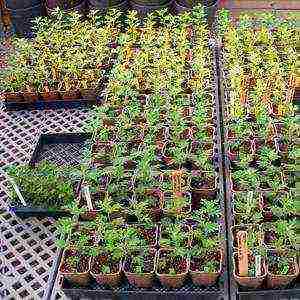 Seedlings in open ground are transplanted at the beginning of summer, and in good weather conditions they do it a little earlier. In this case, you should focus on the temperature of the soil, which should warm up to +14 degrees. The area where chrysanthemums will grow should be well lit by sunlight.... Since most varieties begin to bloom in the fall, the light regime is as natural as possible.
Seedlings in open ground are transplanted at the beginning of summer, and in good weather conditions they do it a little earlier. In this case, you should focus on the temperature of the soil, which should warm up to +14 degrees. The area where chrysanthemums will grow should be well lit by sunlight.... Since most varieties begin to bloom in the fall, the light regime is as natural as possible.
If the chrysanthemum suffers from a lack of sun, then only flower buds begin to form, and with an excess of it, mainly axillary buds, stems and leaves will be laid. Thus, in order for the flower to develop normally, it needs a normal daylight hours.
Windless and flat area
The plant does not like drafts and wind, so it is best to grow chrysanthemums near the house or fence. Besides, for such flowers it is necessary to find a flat area... This is explained by the fact that in the lowland, due to melting snow, water will begin to drain and flood the chrysanthemum. This can also happen during rainy weather.
Care
After the seedlings are planted, it must be properly cared for. First of all, the chrysanthemum must be watered after planting. Lack of moisture will not allow flower buds to form, from which inflorescences subsequently grow. Excess moisture is not terrible for the plant, but too juicy shoots can freeze during autumn frosts.
Chrysanthemum care includes applying fertilizers to the soil, and in moderation. It is necessary to alternate feeding using mineral and organic fertilizers... First, nitrogen fertilizing is applied, and during the laying of buds - phosphorus-potassium. In addition, you should regularly loosen the soil and remove weeds.
Diseases and pests
Usually chrysanthemums are not susceptible to serious diseases. Mostly they are affected by spider mites, but with the help of a soap solution it is easy to get rid of it. Instead of this, you can use the solution "Piterium"... Earth parasites should not be feared either. Aphids that can grow in the flowers themselves do no harm and can be easily washed off with water.
Thus, growing from seeds and caring for a chrysanthemum is a fairly simple matter. Some species can be grown both outdoors and at home. Adhering to certain recommendations, you can achieve a gorgeous flowering in the fall, which will delight the eye for a long time.

